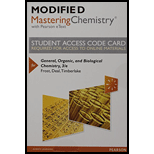
a.
To determine:
The reaction which is faster and which is slower out of the given reactions.
Introduction:
b.
To determine:
The curve which represents endergonic and which represents exergonic reaction.
Introduction:
Thermodynamics is the branch of chemistry which studies the difference of heat and energies of product and reactant in the chemical reaction. Therefore, the sign of free energy change and heat change for the given chemical reaction is predicted by using the concept of thermodynamics.
c.
To determine:
The reaction which is spontaneous out of the given reactions.
Introduction:
Thermodynamics is the branch of chemistry which studies the difference of heat and energies of product and reactant in the chemical reaction. Therefore, the sign of free energy change and heat change for the given chemical reaction is predicted by using the concept of thermodynamics.
d.
To determine:
The reaction having a positive value of free energy change out of the given reactions.
Introduction:
Thermodynamics is the branch of chemistry which studies the difference of heat and energies of product and reactant in the chemical reaction. Therefore, the sign of free energy change and heat change for the given chemical reaction is predicted by using the concept of thermodynamics.
Want to see the full answer?
Check out a sample textbook solution
Chapter 5 Solutions
Modified Mastering Chemistry with Pearson eText -- Standalone Access Card -- for General, Organic, and Biological Chemistry (3rd Edition)
- Consider the following energy plots for a chemical reaction when answering the questions below. a. Which plot (purple or blue) is the catalyzed pathway? How do you know? b. What does E1 represent? c. What does E2 represent? d. Is the reaction endothermic or exothermic?arrow_forwardDoes the equlibrium favor the reactants or the products in each substitution reaction?arrow_forwardComplete the following equation for the reaction (write down no reaction, otherwise no reaction)!arrow_forward
- Which of the following comparisons or contrasts between endergonic and exergonic reactions is false? a. Endergonic reactions have a positive ΔG and exergonic reactions have a negative ΔG. b. Endergonic reactions consume energy and exergonic reactions release energy. c. Both endergonic and exergonic reactions require a small amount of energy to overcome an activation barrier. d. Endergonic reactions take place slowly and exergonic reactions take place quickly.arrow_forwardWhich of the following is true? a. A slow reaction has small Ae to reach the Ts and start forming products. b. A fast reaction has big Ae to reach the Ts and start forming products. c. A exergonic reaction can have big or small Ae to reach the Ts and start forming stable products. (HA) d. A endergonic reaction only has big Ae to reach the Ts and start forming unstable products.arrow_forwardchoose the correct option for each reactionarrow_forward
- Identify the reactant that gets oxidized in the following reaction. 2Al(s) + 6HCl(aq) → 2AlCl₃(aq) + 3H₂(g) A) H in HCl B) Cl in HCl C) Al in AlCl₃ D) Al in Al(s) E) H in H₂arrow_forwardHow did you get the 1st half reaction and 2nd half reaction?arrow_forwardCH2 = CH2 + Br+ CH2-CH2Br This is a step in a ____ reaction where ____ is the electrophilearrow_forward
- Draw the organic products G and H and classify/ name the chemical transformationarrow_forwardExergonic and endergonic reactions differ in that A. exergonic reactions have a positive free energy change (DG is positive) and endergonic reactions have a negative free energy change (DG is negative). B. exergonic reactions require an input of energy and endergonic reactions release free energy. C. exergonic reactions produce products with less free energy than the reactants; endergonic reactions produce products with more free energy than the reactants. D. exergonic reactions consume more free energy than is released and endergonic reactions release more free energy than is consumed.arrow_forwardWrite the equation for each reactionarrow_forward
 Chemistry: An Atoms First ApproachChemistryISBN:9781305079243Author:Steven S. Zumdahl, Susan A. ZumdahlPublisher:Cengage Learning
Chemistry: An Atoms First ApproachChemistryISBN:9781305079243Author:Steven S. Zumdahl, Susan A. ZumdahlPublisher:Cengage Learning ChemistryChemistryISBN:9781305957404Author:Steven S. Zumdahl, Susan A. Zumdahl, Donald J. DeCostePublisher:Cengage Learning
ChemistryChemistryISBN:9781305957404Author:Steven S. Zumdahl, Susan A. Zumdahl, Donald J. DeCostePublisher:Cengage Learning
 Chemistry for Today: General, Organic, and Bioche...ChemistryISBN:9781305960060Author:Spencer L. Seager, Michael R. Slabaugh, Maren S. HansenPublisher:Cengage LearningChemistry: Matter and ChangeChemistryISBN:9780078746376Author:Dinah Zike, Laurel Dingrando, Nicholas Hainen, Cheryl WistromPublisher:Glencoe/McGraw-Hill School Pub Co
Chemistry for Today: General, Organic, and Bioche...ChemistryISBN:9781305960060Author:Spencer L. Seager, Michael R. Slabaugh, Maren S. HansenPublisher:Cengage LearningChemistry: Matter and ChangeChemistryISBN:9780078746376Author:Dinah Zike, Laurel Dingrando, Nicholas Hainen, Cheryl WistromPublisher:Glencoe/McGraw-Hill School Pub Co Living By Chemistry: First Edition TextbookChemistryISBN:9781559539418Author:Angelica StacyPublisher:MAC HIGHER
Living By Chemistry: First Edition TextbookChemistryISBN:9781559539418Author:Angelica StacyPublisher:MAC HIGHER





